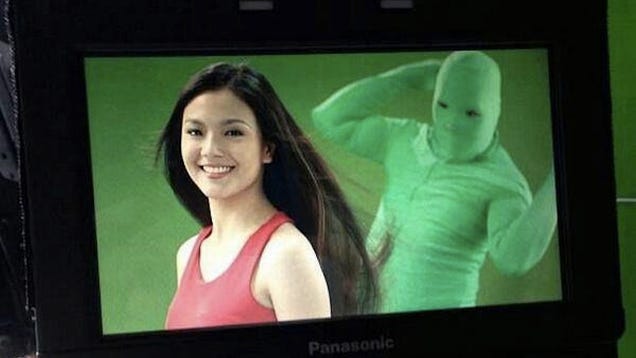Using a green screen has been the norm for years. It feels like it's been forever since I've seen production shots using a blue screen.
Doesn't matter what colour they use, it's what ever works best with the shot and props.
Using a green screen has been the norm for years. It feels like it's been forever since I've seen production shots using a blue screen.
I'm more interested in the way CG is used in films that aren't obviously completely filled with CG; Zodiac being a classic example of a film that was heavily filmed in front of green screens but certainly doesn't feel it.
I think, due to the size difference between Gandalf and the other characters, you'd have to build multiple sets to accommodate for each shot. So, you really have a few options:They need to have human sized actors appear to be different sizes (dwarves, wizards) in the film. In LOTR, a lot of the time, they used forced perspective to achieve this - real, in-camera illusions. Because The Hobbit was being shot in 3d, this kind of stuff doesn't fly, so you've gotta move onto other techniques, in this case, digital insertion.
I admit, I'm not 100% sure why it needs to be on a completely green screen set. Couldn't they have just filmed it on a real set, just without the actors? Either way, the thing that Ian McKellen found most frustrating was the lack of actors to work off of. It's a good example of going so far in the direction of scale and spectacle that you've missed the core necessity of filmmaking - that human emotion that bubbles and ignites from human actors interacting. I'd say that's far more important than 3d. 3d isn't going to be more immersive if your actors are wooden, frustrated and confused.
If this is before adding any visual effects how did they do the see through screens?

green screen and too much CGI though is what made the the hobbit such a shit movie........way, waaaaaayyyyy to fucking overused.
I'm re-watching LOTR right now and the costume work and make-up on the goblins and urak-hai just makes it so much more natural and real looking.
To me fellowship of the ring looks better than any of the hobbit movies just because its more natural looking imo.
Just why?
Why did that need to be a green screen?
That's really cool.Just want to show you guys some nicer CG.
Game of Thrones, Season 5 Episode 8 spoiler, don't watch if you haven't seen that episode yet !
https://fstoppers.com/bts/how-they-made-game-thrones-scene-so-darn-cool-75767
Projectors maybe? Idk
Man, Cavill is such an upgrade.

OUT AM I?
Just why?
Why did that need to be a green screen?
Still makes me laugh.

It's funny - nowadays I'm more impressed when something isn't CG.
Like the way the skies outside the apartment in Oblivion were actually just huge screens with video playing on them.

It's funny - nowadays I'm more impressed when something isn't CG.
Like the way the skies outside the apartment in Oblivion were actually just huge screens with video playing on them.

Pathetic:
I'm a visual effects compositor and the shot from Enders Game is actually my shot, cool!
I loved working on that final battle sequence.
Yep! Though DD in Venice, CA also worked on it.You worked at DD Vancouver ?
How is that any different to green screen though?
This is still my favorite.

Yep! Though DD in Venice, CA also worked on it.
We are generally paid well... at major studios 6 figure incomes for most people considered senior artists. Much more for supervisor positions.What is sad and depressing is how poorly compensated the artists who make the effects possible are. Or all the work is outsourced to countries with even lower pay.
And then the workshops shut down due to bankruptcy even if the film gets accolades (See Life of Pi and Rhythm and Hues controversy)
This is still my favorite.

Pathetic:
How is that any different to green screen though?
We were tired of blue screens. We knew what blue screens would mean to the production design of the set. Theres a scene in the movie with a building thats up in the clouds. Its an all-glass structure, very modern and very open, with very shiny surfaces. Usually, if you get a situation like that and youre doing blue screens, VFX will say, Okay, lets take all the glass out. In fact, thats what they told us to do, Take all the glass out and consider using more matte surfaces and get away from shiny things. Because, with so much glass things get too shiny. When using blue screen the set just disappears and then they end up having to digitally reconstruct the set in post, which gets expensive.
Just why?
Why did that need to be a green screen?
My guess would be the actors can actually see what they're suppose to be looking, fearing, surprised, amazed, etc at instead of relying on what the director is describing the scene to be.
Here's their explanation:
Actually, most of the lighting on set was accomplished through the projection, too. It's a neat idea.
I can't imagine the '90s series "Movie Magic" being as entertaining today because of all these green screen and CGI, in place of miniatures, camera tricks, and practical effect.
:
Its like a green version of Wonka's Television RoomSo that's real? It looks so ridiculous that I always assumed it was from some Late night show skit.
Edit:
Alice in Wonderland is creepy as fuck

Still makes me laugh.

